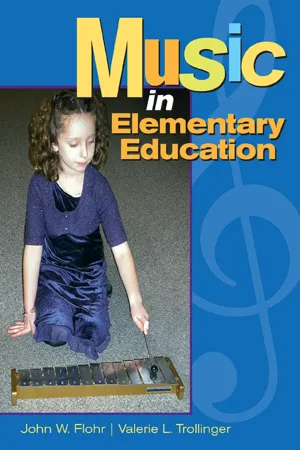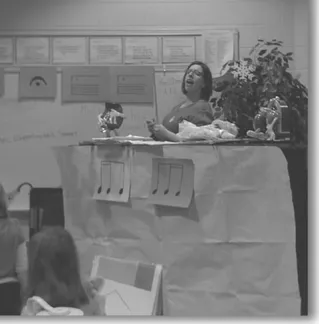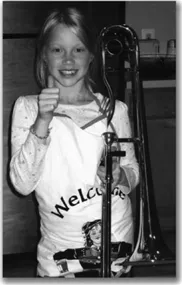
- 336 pages
- English
- ePUB (mobile friendly)
- Available on iOS & Android
eBook - ePub
Music in Elementary Education
About this book
Based on the National Standards, this text is divided into three parts. Part one, Foundations, covers the rationale for a Music Education program in the elementary years; meaning and musical experience; and elements and kinds of music. Part two– Music Elements, Curriculum and Avenues to Music Learning–covers curriculum development; music for special needs students; avenues to music learning and historic and contemporary approaches. Part three–Musical Experiences– is grouped by avenues of music learning and grades. Thanks to years of thorough research, Music in Elementary Education promises is a standard text in the field.
Frequently asked questions
Yes, you can cancel anytime from the Subscription tab in your account settings on the Perlego website. Your subscription will stay active until the end of your current billing period. Learn how to cancel your subscription.
No, books cannot be downloaded as external files, such as PDFs, for use outside of Perlego. However, you can download books within the Perlego app for offline reading on mobile or tablet. Learn more here.
Perlego offers two plans: Essential and Complete
- Essential is ideal for learners and professionals who enjoy exploring a wide range of subjects. Access the Essential Library with 800,000+ trusted titles and best-sellers across business, personal growth, and the humanities. Includes unlimited reading time and Standard Read Aloud voice.
- Complete: Perfect for advanced learners and researchers needing full, unrestricted access. Unlock 1.4M+ books across hundreds of subjects, including academic and specialized titles. The Complete Plan also includes advanced features like Premium Read Aloud and Research Assistant.
We are an online textbook subscription service, where you can get access to an entire online library for less than the price of a single book per month. With over 1 million books across 1000+ topics, we’ve got you covered! Learn more here.
Look out for the read-aloud symbol on your next book to see if you can listen to it. The read-aloud tool reads text aloud for you, highlighting the text as it is being read. You can pause it, speed it up and slow it down. Learn more here.
Yes! You can use the Perlego app on both iOS or Android devices to read anytime, anywhere — even offline. Perfect for commutes or when you’re on the go.
Please note we cannot support devices running on iOS 13 and Android 7 or earlier. Learn more about using the app.
Please note we cannot support devices running on iOS 13 and Android 7 or earlier. Learn more about using the app.
Yes, you can access Music in Elementary Education by John Flohr,Valerie Trollinger in PDF and/or ePUB format, as well as other popular books in Media & Performing Arts & Music. We have over one million books available in our catalogue for you to explore.
Information
PART I
Foundations
CHAPTER 1
Why Music in the
Elementary School?

This chapter addresses the following:
■ Why Music in Elementary Education?
Four Styles
Links Among the Arts and Other Subjects
■ National Standards
■ Chapter Conclusions
WHY MUSIC IN ELEMENTARY EDUCATION?
Whether you plan to be a music or elementary teacher, the current and future education climates indicate that distinct lines among education subject areas are blurring.
Education is moving toward a more global approach that implies knowledge of multiple subject areas is interdependent and often necessary for a child’s success in school and life. This book does not present music as a single isolated discipline but rather as part of the larger educational picture.
What function does music fulfill in children’s elementary education? This section covers several ways in which music may enrich elementary education throughout the day (Calogero 2002; Flohr 2006; Hansen et al. 2004). Music surrounds us—on the radio, television, movies, streets, concert halls, and iPods. How do children benefit from music in the classroom?
Three good ways music benefits and enriches instruction include the following:
1. Self-expression. Music is misused when employed solely as a means of enriching other instruction. Broudy (1972) used the term cherishing when writing about arts education. When we value and cherish the arts, we desire to preserve and care for them for their intrinsic properties, which provide delight. In an essay on arts education, Broudy defined “enlightened cherishing” as “a love of objects and actions that by certain norms and standards are worthy of our love. It is a love that knowledge justifies” (Broudy 1972, 6). Although arts education may significantly benefit a child’s development, we should be cautious about views that emphasize music as a tool to teach other subjects or to provide relaxation. Many activities may serve as tools to teach other subjects or provide relaxation. What makes music and the arts different? Chapter 2 contains a thorough examination of meaning and music.
2. Efficient, enjoyable learning. Music may help teachers and students to achieve goals efficiently and enjoyably. Subjects partnered with music may help children acquire information with ease and speed. When other strategies fail, children, including those with special needs, may retain information carried by melody and/or rhythm; in this way, music can help children learn counting, names of states, colors, grammar—all nonmusical ideas.
3. Professional growth for teachers. Bresler (2002) outlines five major points of impact on teachers who integrate and collaborate with other teachers: They experience (1) a role change as they develop curriculum, not just implement it; (2) focus that moves to broader issues of educating children; (3) exposure to a large array of sources; (4) a major shift in teacher self-image, from isolation to part of children’s whole education, particularly for music specialists; and (5) a change of instructional role for music teachers who now become central rather than marginal to general instruction.
Chapter 2 contains a detailed discussion of music enrichment, music and the brain, parallel objectives, and social benefits of music.
Four Styles
Classroom teachers studied by Bresler (1995) often used one of four styles for integration with the arts. In this chapter, we rename Bresler’s styles as enrichment styles rather than integration styles. The most frequently used style, subservient enrichment, involves music to enrich other subjects without encouraging aesthetic growth in the arts. For example, during cleanup time, a teacher may sing the words, “This is the way we clean up our blocks” to the folk song “Here We Go ‘Round the Mulberry Bush.” Another example is enriching storytelling time with music.
The least used style, coequal cognitive enrichment style, was identified as the most advocated in arts enrichment literature. Classroom teachers who worked with arts specialists or had an artistic background usually used this style. Schools may invite artists for short-term instruction or ongoing arts instruction with classroom teachers. For example, a brass quintet visits a preschool and performs music from a standard repertoire and music based on children’s folk songs (for example, “This Old Man”). Before the visit, the preschool teacher may begin a unit on brass instruments, with listening, pictures, making instruments, and children moving and pretending to play brass instruments. The musicians demonstrate each brass instrument, and then allow children to touch them and try to make sound on a mouthpiece. The brass quintet example involves listening and perceiving, interpreting and analyzing sound, synthesizing individual brass sounds into a quintet, and evaluating characteristics of the instruments.
The third enrichment style, affective style, was identified by the way it set a mood and was the most prevalent in grades K–2 in Bresler’s study. For example, music in the background provides a relaxing mood during individual reading time.
The fourth style, social enrichment, linked the arts to the general curriculum. For example, all of the primary grade students of a school system join together to sing “America” for a patriotic event. This type of activity, usually championed by a principal, may draw public and media attention to the school. Another example is illustrated by a group of preschool teachers asking a music specialist to help with a song for the kindergarten graduation activities in the spring. Finally, children singing a “hello” and “ABC” songs for parents’ day portray the school as involving music in the curriculum.
Links Among the Arts and Other Subjects
Deasy (2002) writes that music and other arts—dance, theater, visual, language, and media—are unique yet connected. Two or more art forms may overlap. For example, movement and music are often combined for children. Each art form is unique in medium of expression and symbolic system, but connected to one another by the expression of aesthetic qualities. Concepts and terms relating to form often cross the arts. For example, repetition in music (a repeated rhythm pattern) may be linked to repetition in dance (a repeated movement). In addition, repetition in music may be linked to repetition in theater (a recurring part of a dramatic story) and in visual arts (repeated colors or shapes in a painting). For more information, visit the Arts Education Partnership website at: http://aep-arts.org/.

Good vocal modeling by the teacher is important in teaching singing.
Photo courtesy of Kelly Riccio
Pitfalls to Avoid. Two important pitfalls need to be avoided. First, for thoughtful enrichment, teachers should retain the unique benefits of music when joining music with other subjects to create a beneficial learning environment. Although music may influence and enhance other learning, it is prudent to remember that music has worth in and of itself and should be used to achieve its own numerous purposes. Second, all music is not of the same quality; music of poor quality is far less effective.
NATIONAL STANDARDS
A major U.S. national policy act gives the arts a firm position in schools and additional reasons for teaching music to young children. Public Law 107–110, entitled Elementary and Secondary Education Act or No Child Left Behind of 2001, includes the arts in the definition of core academic subjects. Title IX, part A–definitions, Section 9101 (11) of the law defines core academic subjects: “The term core academic subjects means English, reading or language arts, mathematics, science, foreign languages, civics and government, economics, arts, history, and geography” (U.S. Department of Education 2003).
National, state, district, and local school standards are available for organizing teaching. National and state content area associations (for example, mathematics, language arts, music, and dance) list standards on their websites. The national music standards from the National Association for Music Education (which uses the acronym MENC) are used for the music purposes of this book. The national standards are voluntary guidelines; there are no national standards for inspectors to use while visiting and reviewing schools. School district and state standards are often included in teacher evaluation. The following are MENC content standards:
1. Singing, alone and with others, a varied repertoire of music
2. Performing on instruments, alone and with others, a varied repertoire of music
3. Improvising melodies, variations, and accompaniments
4. Composing and arranging music within specified guidelines
5. Reading and notating music
6. Listening to, analyzing, and describing music
7. Evaluating music and music performances
8. Understanding relationships between music, the other arts, and disciplines outside the arts
9. Understanding music in relation to history and culture (MENC 1994b)
For a complete listing of achievement standards, see “Opportunity-to-learn Standards for Music Instruction: Grades PreK-12” (MENC 1994a).
Chapter Conclusions
There are many reasons why music is valuable for elementary classrooms. Three reasons for enriching instruction with music are (1) benefits such as self-expression; (2) teachers and children reach goals efficiently and enjoyably because music is a good vehicle for learning information; and (3) music provides professional growth for teachers. National and state education standards include music and the arts as part of the core curriculum.
CHAPTER 2
Meaning and Music

This chapter addresses the following:
■ Values in Music
■ Human Values and Philosophy in Music
Philosophical Foundations of Music
■ Psychology of Music
■ Music and the Brain
Interaction of Philosophy, Psychology, Teaching, and Learning
■ Learning Theories
Behavioral Approaches
Cognitive Approaches
Cognitive Processing Styles
Personality
Social-Emotional Approaches
■ Intersection of Learning and Instruction
Bloom’s Taxonomy
Constructivism
Process Learning
Developmentally Appropriate Practice
Processing Multiple Objectives
Enrichment
Parallel Objectives
The Whole Child
Social Concerns
Summary and Relationship of Music Learning and Instruction
Experiences for Groups or Individuals
■ Chapter Conclusions
VALUES IN MUSIC
This section of the book introduces relationships among humans, music, and meaning. These relationships are not simple, nor can they be investigated or defined simply. Rather, you will be introduced to dynamic and intricate convolutions of how humans, music, and meaning interact, and subsequently how they affect how you teach and how your students learn. We encourage you to investigate references listed throughout this chapter, read articles and books by music philosophers we discuss, and find your own meaning in music. Many have a great deal to contribute to what we generally accept as meaningful and valuable in music education, but ultimately your values and meanings will drive your teaching career. However, there is a caveat. To logically derive your beliefs about music and music education requires that you be informed about what actually has been going on in the fields of music and education that have a direct impact upon what we eventually teach in our classrooms.
HUMAN VALUES AND PHILOSOPHY IN MUSIC
The term value in education has been bandied around in a number of contexts, from the late 1980s into the 1990s, as value-based education to the current No Child Left Behind model that promotes the values of science, mathematics, and reading. There are many meanings for one small word, value. As a culture, the term value implies worth, importance, usefulness, or even monetary gains. Value can also imply a moral, ethical, or ideal construct. In the study of attributes that comprise beauty, aesthetic value is determined by perceived and agreed upon beauty found in each art. Wars start over values, economic contracts are made or broken over values, and governments rise and fall over values. One person or culture may believe something is valuable, whereas another person or culture may not.

Playing an instrument can be a positive experience.
Photo courtesy of Lorraine Trollinger
Within this framework, we make the following statement: Music has value in our schools. As musicians and music educators, we fight for quality music education under metaphorical banners bearing this statement. We have conferences, from local to international, to help promote and solidify the value of music education in schools worldwide. The belief that music has value seems to be ...
Table of contents
- Cover
- Half Title
- Title Page
- Copyright Page
- Table of Contents
- Preface
- Acknowledgments
- List of Contributors
- To the Student
- To the Instructor
- Part I Foundations
- Part II Music Elements, Curriculum, and Avenues to Music Learning
- Part III Musical Experiences
- Appendix 1 List of Songs
- Appendix 2 List of Figures
- Appendix 3 List of Tables
- Glossary
- References
- Index